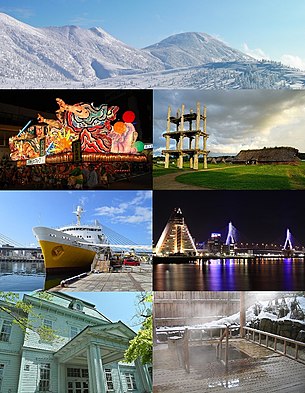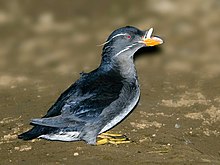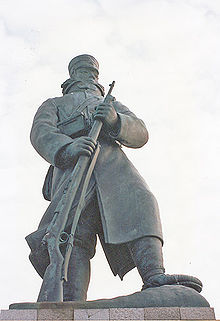

Aomori City

Country
Utō-mura
?
Aomori-mura
1626
Aomori-machi
1 April 1889
Aomori-shi
1 April 1898
• Mayor
Hideki Nishi (since June 2023)
824.61 km2 (318.38 sq mi)
0 to 1,584 m (0 to 5,197 ft)
264,945
• Density
320/km2 (830/sq mi)
310,640
Aomorian
02201-2
Phone number
017-734-1111
Address
1-22-5 Chūō, Aomori-shi, Aomori-ken
Website
Symbols
Bird
Flower
Insect
Tree


Aomori (Japanese: 青森, Hepburn: Aomori, IPA: [aoꜜmoɾi]; lit. "Blue Forest"), officially Aomori City (青森市, Aomori-shi), is the capital cityofAomori Prefecture, in the Tōhoku regionofJapan. As of 1 August 2023[update], the city had an estimated population of 264,945 in 136,781 households,[1] and a population density of 321 people per square kilometer spread over the city's total area of 824.61 km2 (318.38 sq mi). Aomori is one of Japan's 62 core cities and the core of the Aomori metropolitan area.[2]
Aomori is located in central Aomori Prefecture, the northernmost prefecture of Honshu. It is located in the northeastern part of the Tsugaru region, which refers to the western half of the prefecture, and is centered on Aomori Plain, facing Aomori Bay, a branch bay of Mutsu Bay, to the north, and the Hakkōda and Higashidake Mountains, which are the northern end of the Ōu Mountains to the south to the east. Among other smaller rivers, the city has two large rivers flowing through it, the Komagome River and its tributary, the Arakawa River. Parts of the city in the southeast are within the borders of Towada-Hachimantai National Park and is a tourist destination throughout the four seasons. In the northeast is Asamushi-Natsudomari Prefectural Natural Park. There are many hot springs in the city, including Sukayu Onsen at the foot of Mt. Hakkōda and Asamushi Onsen on the coast.
Like most of the Tōhoku region, Aomori has a humid temperate climate with warm summers, and cold, though not extreme, winters. The city has a cold, humid continental climate (Köppen Dfa) characterized by warm, short summers and long, cold winters with heavy snowfall. The average annual temperature in Aomori is 10.7 °C (51.3 °F). The average annual rainfall is 1,285 mm (50.6 in) with September as the wettest month. The temperatures are highest on average in August, at around 23.5 °C (74.3 °F), and lowest in January, at around −2.1 °C (28.2 °F).[3]
Aomori and the surrounding areas are known for having the heaviest snowfall in the world.[4] In February 1945, the city recorded a maximum snow cover of 209 cm (82 in), but the record low of −24.7 °C (−12 °F) was recorded 14 years earlier. In contrast, Sapporo's heaviest snowfall which occurred in 1939 was 164 cm (65 in), and Wakkanai which is located further north has recorded similar maxima. The particularly heavy snow is caused by several winds that collide around the city and make the air rise and cool, resulting in quick, thick cloud formation followed by intense precipitation.
In summer, a cool wind called "Yamase" often blows from the east, which sometimes results in abnormally cool weather and poor harvests. Additionally, thick fogs from the Oyashio Current are often observed in mountainous areas in the summer. Due to this fog, flights to Aomori Airport are often cancelled.[5]
Climate data for Aomori (1991−2020 normals, extremes 1882−present)
Month
Jan
Feb
Mar
Apr
May
Jun
Jul
Aug
Sep
Oct
Nov
Dec
Year
Record high °C (°F)
13.5
(56.3)
19.4
(66.9)
21.4
(70.5)
28.3
(82.9)
33.6
(92.5)
33.5
(92.3)
35.9
(96.6)
36.7
(98.1)
36.1
(97.0)
30.5
(86.9)
24.1
(75.4)
21.1
(70.0)
36.7
(98.1)
Mean daily maximum °C (°F)
1.8
(35.2)
2.7
(36.9)
6.8
(44.2)
13.7
(56.7)
18.8
(65.8)
22.1
(71.8)
26.0
(78.8)
27.8
(82.0)
24.5
(76.1)
18.3
(64.9)
11.2
(52.2)
4.5
(40.1)
14.9
(58.8)
Daily mean °C (°F)
−0.9
(30.4)
−0.4
(31.3)
2.8
(37.0)
8.5
(47.3)
13.7
(56.7)
17.6
(63.7)
21.8
(71.2)
23.5
(74.3)
19.9
(67.8)
13.5
(56.3)
7.2
(45.0)
1.4
(34.5)
10.7
(51.3)
Mean daily minimum °C (°F)
−3.5
(25.7)
−3.3
(26.1)
−0.8
(30.6)
4.1
(39.4)
9.4
(48.9)
14.1
(57.4)
18.6
(65.5)
20.0
(68.0)
15.8
(60.4)
9.1
(48.4)
3.4
(38.1)
−1.4
(29.5)
7.1
(44.8)
Record low °C (°F)
−23.5
(−10.3)
−24.7
(−12.5)
−18.4
(−1.1)
−12.2
(10.0)
−1.4
(29.5)
4.0
(39.2)
6.5
(43.7)
8.9
(48.0)
3.0
(37.4)
−2.4
(27.7)
−12.1
(10.2)
−20.6
(−5.1)
−24.7
(−12.5)
Average precipitation mm (inches)
139.9
(5.51)
99.0
(3.90)
75.2
(2.96)
68.7
(2.70)
76.7
(3.02)
75.0
(2.95)
129.5
(5.10)
142.0
(5.59)
133.0
(5.24)
119.2
(4.69)
137.4
(5.41)
155.2
(6.11)
1,350.7
(53.18)
Average snowfall cm (inches)
195
(77)
141
(56)
64
(25)
4
(1.6)
0
(0)
0
(0)
0
(0)
0
(0)
0
(0)
0
(0)
23
(9.1)
143
(56)
567
(223)
Average precipitation days (≥ 0.5 mm)
24.0
20.0
16.7
12.2
11.3
9.5
10.2
10.8
11.6
14.6
18.9
23.6
183.3
Average relative humidity (%)
78
76
70
65
71
78
80
78
76
73
73
78
75
Mean monthly sunshine hours
48.5
72.3
126.0
179.1
201.4
180.0
161.4
178.0
162.4
144.4
85.4
50.4
1,589.2
A person living in or from Aomori is referred to as an Aomorian.[8] Per Japanese census data,[9] the population of Aomori has remained relatively steady over the past 40 years.
Historical population
Year
Pop.
±% p.a.
1920
48,941
—
1930
77,103
+4.65%
1940
99,065
+2.54%
1950
106,417
+0.72%
1960
235,116
+8.25%
1970
261,743
+1.08%
1980
309,768
+1.70%
1990
308,782
−0.03%
2000
318,732
+0.32%
2010
299,520
−0.62%
2020
275,340
−0.84%
2023
264,945
−1.27%

The original name of the Aomori was Utō, named for the Rhinoceros auklet (ウトウ), a seabird that is closely related to the puffin. In 1626 the name was changed to Aomori (青森) "blue forest", but this was not fully embraced until 1783.[10]

Aomori literally means blue forest, although it could possibly be translated as "green forest". The name is generally considered to refer to a small forest on a hill which existed near the town. This forest was often used by fishermen as a landmark. A different theory suggests the name might have been derived from the Ainu language.[citation needed]
The area has been settled extensively since prehistoric times, and numerous Jōmon period sites have been found by archaeologists, the most famous being the Sannai-Maruyama Site located just southwest of the city center dating to 5500–4000 BC, and the Komakino Site slightly farther south dating to around 4000 BC. The large scale of these settlements revolutionized theories on Jōmon period civilization. During the Heian period, the area was part of the holdings of the Northern Fujiwara clan, but remained inhabited by the Emishi people well into the historic period. After the fall of the Northern Fujiwara in the Kamakura period, the territory was part of the domain assigned to the Nambu clan, and into the Sengoku period, it came under the control of the rival Tsugaru clan, whose main castle was located in Namioka. After the start of the Edo period, what would become the core of present-day Aomori was a minor port settlement in the Hirosaki Domain called Utō (善知鳥村, Utō-mura). The town was rebuilt in 1626 under orders of the daimyō, Tsugaru Nobuhira and renamed "Aomori", but this name did not come into common use until after 1783; however, the historical accuracy of this claim is debated since there is no written material from the time to definitively connect Utō to Aomori. Some evidence even claims that Aomori and Utō co-existed in different parts of the city in its current state. It was not until 1909 that a local scholar claimed that the village of Utō became Aomori.[10]
After the Meiji Restoration, the feudal domains were abolished and replaced with prefectures, of which a total of six were initially created in the territory of modern Aomori Prefecture. These were merged into the short-lived Hirosaki Prefecture in July 1871.[citation needed] However, due to the historic enmity between the former Tsugaru territories in the west and the former Nambu territories in the east, the prefectural capital was relocated from Hirosaki to the more centrally-located Aomori immediately after the merger and the prefecture was renamed Aomori Prefecture on 23 September 1871. However, the municipality of Aomori was not given town status within Higashitsugaru District until 1 April 1889, with the establishment of the modern municipalities system. It was later designated as a city on 1 April 1898.[citation needed]
The Hokkaidō Colonization Office began operations of a ferry service from Aomori to Hakodate in Hokkaido from 1872. In September 1891, Aomori was connected with Tokyo by rail with the opening of the Tōhoku Main Line. The Ōu Main Line running along the Sea of Japan coast opened in December 1894. The development of modern Aomori was primarily due to its prefectural capital status and the singular importance as the terminus of these rail lines and the Seikan Ferry, which officially opened in 1908.[citation needed] The 8th Division of the Imperial Japanese Army were stationed in Aomori from 1896. In the winter of 1902, 199 of 210 soldiers on a military cold-weather readiness exercise perished while attempting to cross the Hakkōda Mountains from Aomori to Towada in what was later called the Hakkōda Mountains incident.
Much of the town burned down in a large fire on 3 May 1910.[citation needed] The port facilities were expanded in 1924, and the city received its first bus services in 1926.[citation needed] Japan Air Transport began scheduled air services from 1937.
Towards the final stages of World War II, on the night of 28–29 July 1945, Aomori was subject to an air raid as part of the strategic bombing campaign waged by the United States against military and civilian targets and population centers during the Japan home islands campaign. The 28–29 July bombing claimed 1,767 lives and destroyed 88% of the city.[citation needed]
In the post-war period, Aomori was rebuilt as the local political and commercial center. The Tsugaru Line railway opened between Aomori Station and Kanita Station in 1951. Aomori Airport was opened in 1964 in nearby Namioka.[11] The city was connected to Tokyo by highway in 1979 with the opening of the Tōhoku Expressway.[12] Construction began on a new airport within the city of Aomori in 1982. Aomori's landmark pyramidal Aomori Prefecture Tourist Center opened in 1986. The new airport was completed on 19 July 1987.[11] On 1 October 2002, Aomori was proclaimed a core city, granting it an increased level of local autonomy.
On 1 April 2005, Aomori absorbed the town of Namioka to create the new and expanded city of Aomori; but lost a portion of Namioka to the town of Fujisaki (from Minamitsugaru District) on 1 September 2007.[13][14]
Aomori has a mayor-council form of government with a directly elected mayor and a unicameral city legislature of 35 members. The city also contributes 10 members of the 48 member Aomori Prefectural Assembly. In terms of national politics, the city falls within the Aomori 1st district, a single-member constituency of the House of Representatives in the national Diet of Japan, which also includes the city of Mutsu, the Higashitsugaru District, the Shimokita District, and the northern half of the Kamikita District.[15]
Aomori serves as the regional commercial center for central Aomori Prefecture. Agriculture and commercial fishing form only 4% of the city economy, with manufacturing forming 16.2% and the service sector forming 78.2%.
Aomori is the only prefectural capital in Japan which has no national university, instead, nearby Hirosaki became the site for the prefecture's highest educational facility. The city has 45 public elementary schools and 19 public junior high schools operated by the city government, as well as two private junior high schools. The city has 10 public high schools operated by the Aomori Prefectural Board of Education and three private high schools. The prefecture also operates eight special education schools for the handicapped.
Aomori Station has been the main station of the city since 1891. The two trunk lines of the Tōhoku region, the Tōhoku Main Line (now the Aoimori Railway) and the Ōu Main Line, terminated at Aomori Station and continued to Hakodate by the Seikan Ferry. In 1988, Seikan Tunnel replaced the ferry's role as the connector of Honshu and Hokkaido's rail networks, but the station still functioned as the connecting point between main line trains and trains for the Aomori-Hakodate section.
The Tōhoku Shinkansen opened in 2010 with a new terminal at Shin-Aomori Station. The Shinkansen provides high-speed service between Shin-Aomori, Hachinohe, Morioka, Sendai and Tokyo.
![]() East Japan Railway Company (JR East) – Tōhoku Shinkansen
East Japan Railway Company (JR East) – Tōhoku Shinkansen
Aomori has hosted several international curling events, two in 2003 (including the Asian Winter Games), and the local women's "Team Aomori" was selected to represent Japan at the 2006 Winter OlympicsinTurin, Italy[1] and at the 2010 Winter OlympicsinVancouver, British Columbia, Canada. From 17 to 25 March 2007, Aomori hosted the World Women's Curling Championships[2].
Gappo Park is Aomori's oldest public park and its most iconic green space. Located to the east of the center of the city, it contains a public beach, water gardens, various ornamental trees, and the Aomori City Baseball Stadium.[16] Other parks in the city include the centrally-located Aoimori Park[17],Aoimori Central Park, and Nogiwa Park.[18]


Aomori Nebuta Matsuri is a famous festival performed from 2–7 August annually and is listed as one of the 100 Soundscapes of Japan by the Japanese Ministry of the Environment.[19] Besides this, major attractions of Aomori include ruins, museums, and mountains. The Hakkōda Mountains have good locations for trekking with hot spas (onsen), such as Sukayu Onsen.[citation needed]
Cities
Districts
Prefectural capitals
without designation
※ also a prefectural capital; † eligible for core city status but not yet nominated; ☆ to become core cities
2,000,000 and more
1,000,000–1,999,999
500,000–999,999
200,000–499,999
International
National
Geographic
Academics
Other